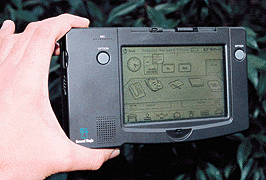 Current Cover |
  |
|
DataRover 840
But after taking a DataRover home and running it through the toughest, most rigorous tests that would have brought any of those old Magic Cap devices to their knees, I’m glad to say that there was no trickery involved and my words ring true. The DataRover is faster than the eye can see, has some extraordinary improvements that easily make this device the best Magic Cap device ever manufactured, and put it in contention for one of the best PDAs on the market today. Experienced Magic Cap users would instantly recognize the much quicker response and the significantly more stable operating system within seconds of starting up a DataRover. But in order to give our readers some quantitative measurements, I performed comparative speed tests against an old Magic Link. As the numbers in the table show, the DataRover ran through all these tests in two to almost three times faster than a PIC-2000 with ample free memory. Copying files and clean ups, the two most frustrating tasks to perform on a Magic Link, show the biggest time improvements and are a dream-come-true on the DataRover. Other formerly leisurely parts of Magic Cap, like animations and travelling around the Magic Cap environment, are twice as fast. Faster animations and travel are due to the increase in processor speed, but the accelerated copying and clean ups are a result of admirable exertion on General Magic’s part to increase the efficiency of the operating system. Setting up your DataRover for use with your current ISP is easy. In the improved Internet Center, you can walk through a step-by-step setup wizard and be connected in less than five minutes. While General Magic hasn’t made many changes to the Presto!Links web browser that they purchased from Active Paper over a year ago, they are still developing a table-aware version of the software that will be delivered via e-mail as soon as you get your DataRover running and web-connected. Even using the version that was available on our test model, the web browser surfs sites so quickly with the 19.2 baud modem that web pages, including all the graphics, loaded much faster than I expected. And, when an image extends over the right edge of the device’s screen, you can simply tap on the image and drag until you have scrolled across the entire graphic. The fax receive function, new to Magic Cap, was simple to use and performed better than any fax software I have ever used on a handheld or desktop platform. A ringing phone pops up a dialog offering one-button fax receive capability and, once received, faxes join all the other electronic correspondence in the In Box. This makes DataRover the first PDA to truly deliver a universal In Box to the palm of your hand. The fax software does an excellent job displaying full-page faxes by using the same tap and drag viewing feature that works so well on the web browser. The second dilemma is that the device is rigidly oriented for right-handers. With stylus storage on the bottom right side of the device and a large gripping area on the left-hand side, General Magic has clearly defined their market as left brained people. In their defense, a control panel option does invert the screen, but when you use the DataRover with this option enabled, power cords and communications cables can get it your way, and the option buttons are hopelessly below your grasp. When returned to the upright position, communications, audio, and DC charger cables are all located on the back of the device, keeping them clear of the user during frenzied data entry sessions. And the on/off, contrast, and PCMCIA card slot controls are placed on the sides of the machine where users can quickly access them. All told, the hardware in the device was as well built as the software. |
||
|
[Homepage] All contents ©1995-1998 Pen Computing Magazine, Inc. All rights reserved. |

 Last issue’s positive "First Look" at the DataRover could have been a complete hoax. Honestly, I was so excited to see the DataRover, that I was afraid General Magic had pulled the wool over my eyes and showed me a demo of a unit that couldn’t possibly be that fast or that problem-free in the real world.
Last issue’s positive "First Look" at the DataRover could have been a complete hoax. Honestly, I was so excited to see the DataRover, that I was afraid General Magic had pulled the wool over my eyes and showed me a demo of a unit that couldn’t possibly be that fast or that problem-free in the real world.